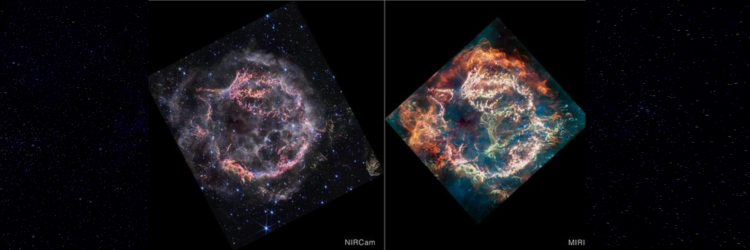
NASA’s Webb Yields Amazing Look at Exploded Star
As part of the 2023 Holidays at the White House, First Lady Jill Biden debuted the first-ever White House Advent Calendar and is celebrating with this new image from the JWST. In it, supernova remnant Cassiopeia A (Cas A) gleams against the vast darkness of space.
In April 2023, Webb’s MIRI (Mid-Infrared Instrument) revealed new and unexpected features within the inner shell of the supernova remnant. These features are invisible in the new NIRCam image, and astronomers are investigating why.
In this newest image of Cas A, they assigned colors to different filters from NIRCam. Each of the colors hints at different activity occurring within the object.
The most noticeable colors in Webb’s newest image are clumps represented in bright orange and light pink that make up the inner shell of the supernova remnant. Webb can detect the tiniest knots of gas, comprised of sulfur, oxygen, argon, and neon, from the star itself. Embedded in this gas is debris that is too tiny to be resolved by even Webb, meaning they are comparable to or less than 10 billion miles across. The entirety of Cas A spans 10 light-years across, or 60 trillion miles.
When comparing Webb’s new near-infrared view of Cas A with the mid-infrared view, its inner cavity and outermost shell are curiously devoid of color.
The outskirts of the inner shell, which show as a deep orange and red in the MIRI image, now look like smoke from a campfire. The dust in the circumstellar material is too cool to be detected directly at near-infrared wavelengths but lights up in the mid-infrared.
Also not seen in the near-infrared view is the loop of green light in the central cavity of Cas A. The team nicknamed this area “the Green Monster.” The ‘green’ of the Green Monster is not visible in NIRCam; what’s left over in the near-infrared in that region provides insight. Circular holes in the MIRI image are outlined in white and purple emission in the NIRCam image and represent ionized gas. Researchers believe this is due to the supernova debris pushing through and sculpting gas left behind by the star before it exploded.
